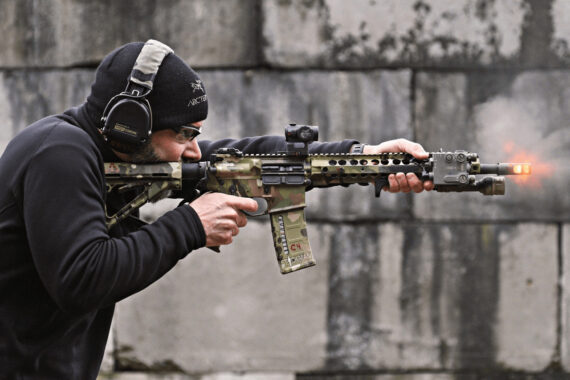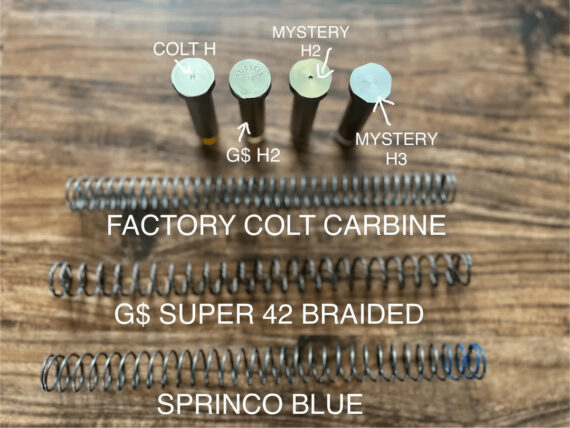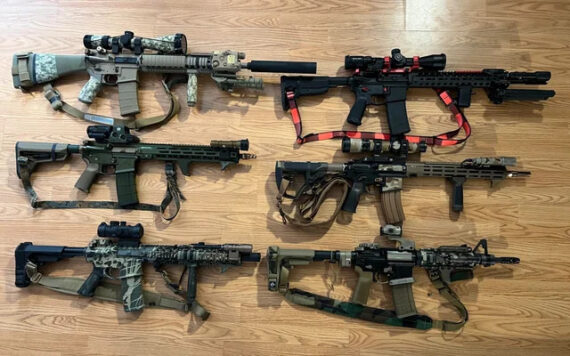Reducing The Recoil of the AR-15: Achieving No Muzzle Rise
The AR-15 is well-loved for its lightweight frame and low recoil. Depending on how your rifle was built, the ammo you’re using, and your grip, you may be able to lower that recoil even more.
How? Well, that’s what we’re going to talk about today. I’ve built many AR-15s over the years and done plenty of tuning and part changing to get that muzzle as flat as possible.
There are plenty of ways to reduce the muzzle rise, from adjusting the weight of moving parts to simply adjusting your stance. Reducing the recoil of your AR-15 is likely easier than you think.
The Free Way
In some cases, you don’t have to spend any money to reduce the recoil of your AR-15. Changing how you grip the handguard and your stance can have a significant impact on how your rifle moves when fired.
Handguard Grip
Are you still holding your AR-15 by the magazine? Or maybe you’re still cupping the handguard. Either way, your hand is not how it should be to lower the recoil and make that rifle easier to maneuver.
Your grip should be as close to the front of the muzzle as possible in a C-clamp fashion, meaning your thumb on your support hand should be over the top of the handguard, and the rest of your fingers should be under.
This allows you to pull the rifle into your shoulder easier, and your shoulder should likewise push back against the rifle to lock it in place.
Think of it as a push-and-pull action.

This is how your support arm and hand should look. Source: Reddit
Stance
If your AR-15 is knocking you off balance, you may be leaning too far back or don’t have your feet in the correct position.
To ensure your stance is correct, your lead foot should point at the target to help with a natural point of aim, while your back foot should be at a 45-degree angle. Additionally, leaning forward will help mitigate the recoil and maximize control.
This will help prevent you from getting pushed back by your rifle and align you in a comfortable position with the target.
Attachments and Parts
Adding attachments such as a grip or changing your buffer and buffer spring are some of the best ways to lower the recoil on your AR-15. The best part is that they’re not all that expensive and are not hard to change.
Foregrip
Foregrips are attached to the bottom of your handguard using one of three different mounting systems: Picatinny, M-Lok, or KeyMod.
They come in many shapes, sizes, and angles, but vertical grips are my favorite for controlling recoil.
Vertical grips help you pull the rifle into your shoulder and give your wrist a more natural angle. They also help with maneuverability, which is super important when using a rifle for defensive purposes.
Your grip should be positioned where your support hand would be on your rifle. With vertical grips, you can still achieve a proper C-clamp grip by using your middle, ring, and pinky finger to pull the rifle in while the thumb stays over the top of the handguard.

The more to grab onto, the better. Source: quora
Buffer
The buffer’s sole purpose is to absorb recoil and return the bolt carrier group back to the locked position. It slows the bolt carrier group down and pushes it forward.
Without it, you have a bolt-action rifle. But not the kind you would want.
So, it would make sense that having a heavier buffer spring would help reduce the amount of recoil, right? Yes. But you have to be careful here. Too heavy of a buffer can result in your bolt carrier group being unable to extract the round.
For that reason, I recommend not making drastic changes in buffer weights. If you currently run an H1 buffer and you want to reduce the recoil, move up to an H2 buffer.
But the buffer spring also serves a huge role in the amount of recoil. So let’s get to that too.
Buffer Spring
A buffer spring’s purpose is to aid the buffer in pushing the bolt carrier group forward. And like regular springs, they come softer or stiffer.
A softer spring will result in more felt recoil, while a stiffer spring will help keep that bolt carrier group from slamming into your shoulder.
But again, this begs the question, “Is there too heavy or, in this case, too stiff?”
Yes. Yes, there is. Too heavy of a spring can result in the same malfunctions that a heavy buffer could. Your rifle won’t cycle correctly.
Sprinco Recoil Solutions makes some of the best buffer springs. I run Sprinco’s green spring on my 14.5” build with a VLTOR H2 buffer, and my rifle has virtually no recoil.

Different buffers and buffer springs. Source: reddit
Ammo
You can find 5.56×45 in many different grain weights.
Typically, the ammo you find at your local FFL will be 55-grain or 62-grain. Between the two, 55 grain will produce less felt recoil than 62 grain, but only marginally.
There are also heavier grain weights, such as 62, 69, 75, 77, and 87.
Of course, if you go shooting 55 grain and then shoot 87 right after, there will be a noticeable increase in felt recoil.
This is due to the extra weight being pushed out of the barrel. Some ammo is also gassier than others due to the powder and seating of the round.
If you want to keep recoil down, use a lighter grain weight. But don’t forget about the barrel.
Barrel Length
The shorter the barrel, the more recoil you’ll feel. And if you’re running a suppressor on the end of that barrel, the felt recoil will increase even more.
However, barrel length can be offset by changing out your buffer and buffer spring, so shorter barrels are typically run with heavier buffers and buffer springs.
If you want to reduce felt recoil, consider running a longer barrel length or doing the aforementioned and changing out your spring and buffer.

Which one do you think produces the lightest felt recoil? Source: reddit
Conclusion
Reducing the felt recoil of your AR-15 is fairly easy once you learn the tricks.
If you’re shooting with a shorter barrel, increase the weight of your buffer and buffer spring.
Utilize certain attachments, such as a vertical foregrip, and lock the rifle between your support hand and your shoulder with a proper C-clamp.
Lean into it, but not too much. Get that dominant leg back and lean into the support leg, which would be on the same side as your support hand.
Any AR-15 can shoot flatter than roadkill with the proper parts and technique. All it takes is practice.
Be good and take care.